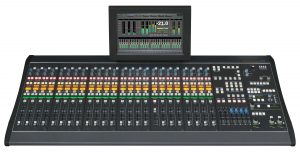Tech Focus: Audio Mixers, Part 1 — Evolution of the At-Home–Production Console
IP is now nearly ubiquitous; next up: modularization and automation
Story Highlights
If audio is the canary in broadcast’s coal mine, the mix console is its perch. That pro-audio category has followed an evolutionary path from analog to digital to IP. Now, as the REMI/at-home–production model moves from novelty to standard operating procedure, the audio desk is increasingly modularized and automated.
Lawo, which asserts more than 90% market share for conventional consoles in OB vans in Europe, is following a modularized path into the future of the audio desk, propelled by an already deep investment in IP-based audio and video systems. According to VP, Business Development, Don Bird, several hundred Lawo Commentary Units (LCUs) are deployed by Fox Sports, NBC Sports, ESPN, and others for the 2018 FIFA World Cup games in a dozen cities across Russia. They are feeding digital audio to Lawo mc²96 Grand Production consoles at various audio-control rooms. Also being deployed for at-home–style production are other modular units — including the Lawo Compact Engine AES67 audio node with on-board DSP and the Power Core 1RU IP-based mix engine with modular I/O options — capable of performing all audio-mixing and -routing functions under remote control of vision mixers or third-party automation systems.
Says Bird, “You can use automated mixing and other functions remotely and create a much more efficient infrastructure for audio for very large-scale productions.”
Calrec’s RP1 2RU remote-production system enables a remotely located audio-mixing–console surface to control all mixing functionality at another facility or location, with the RP1 core managing all processing for IFB routing and remote-monitor mixes.
According to Henry Goodman, director, product development, Calrec, none of this modularization would be possible without a solid IP infrastructure already in place. Longer term, he predicts, even consoles themselves will deploy switch-based routing internally, which would complete the transition from linear-signal to data-packet transport.
Platforms like the RP1 contribute to reduced overhead costs for legacy sports broadcasters, such as Univision and NBC Sports, according to Chris Fichera, VP, audio, Group One Ltd., the North American distributor for DiGiCo and Calrec (which share a parent company with the Allen & Heath and Solid Stage Logic brands). Such platforms also have the potential to become primary platforms for a range of midsize collegiate networks. Specifically, he points to the PAC-12 Conference’s PAC-12 Networks as an example.
“Football and basketball bring in the bulk of the revenue,” he points out, “but colleges have many other sports that have to be covered as part of the school’s athletics, from water polo to field hockey, and need to get their airtime. At-home tools like the RP1 are well-suited for that role: an A2 plugs the mics in onsite, and the audio gets mixed back at the control room.”
An even newer suite of products — DiGiCo’s 4REA4 (pronounced “area four”), which was shown in June at the 2018 InfoComm Show, and Calrec’s related TypeR — puts remote–audio-production tools almost entirely in a virtual and IP transport realm and modularizes them, letting users configure remote-production systems to fit different scales. The processing-engine rack has four dedicated mix areas, or zones, each with its own stereo master output, CGs, and allocated FX.
“Remote production is pushing us further away from the idea of a big piece of hardware to do the mix on,” Fichera explains. “Instead of plopping a console down somewhere, you’ll pick the individual modules each situation requires and transport the audio back to a similar platform at a central location. You can mix part of the show onsite and another part at home.”
It’s not just modularization of the components of an audio-mixing system, he contends: it’s the modularization of the very process of mixing itself.
That concept is taking hold. Wheatstone made its name with audio consoles designed for the studio, although its smaller Series Two and Series Four desks have remote-operations applications. However, the company’s Blade technology — Wheatstone’s terminology for its “smart” I/O units with integrated CPU and OS that modularize such functions as DSP and connects processing with complementary units that address specific tasks, such as its BLADE-3 control-surface engines/mixers — puts that IP-based technology squarely in the remote-production category.
“A broadcast can ingest audio remotely through the Blade and move that audio from console to console over Ethernet,” explains Wheatstone Senior Sales Engineer Brad Harrison. The arrival of the AES67 intercompatibility protocol, he adds, means that the Blade, which is in use with the Portland Trailblazers’ radio production, can have broader applications in systems that use other brands’ products. He calls the Blade — pun intended — the tip of the spear for Wheatstone in the at-home–production market and says other sports applications are under development (though not yet disclosable, as products in this part of the broadcast-audio universe transition from merely novel to highly competitive).
The Bigger Picture
Modularization and automation are clearly going to be the next phase of development for audio mixing and routing, now that the pathway to IP-based signal transport has been established. The trend is possible thanks to significant improvements in DSP and a better understanding of how networked audio can work in an industry that has to manage signals from a wide variety of sources over ever longer distances.
But it’s also being accelerated by the imminent and massive consolidation transactions involving Comcast, Disney, Sky, and Fox — all major sports producers — that, once settled, will inevitably lead to deep rounds of cost-cutting. In that context, advances in mixing audio for remote broadcast production is as much an exercise in economics as it is technology.
Click here for Tech Focus: Audio Mixers, Part 2 — Diversity in Consoles for At-Home Production.

